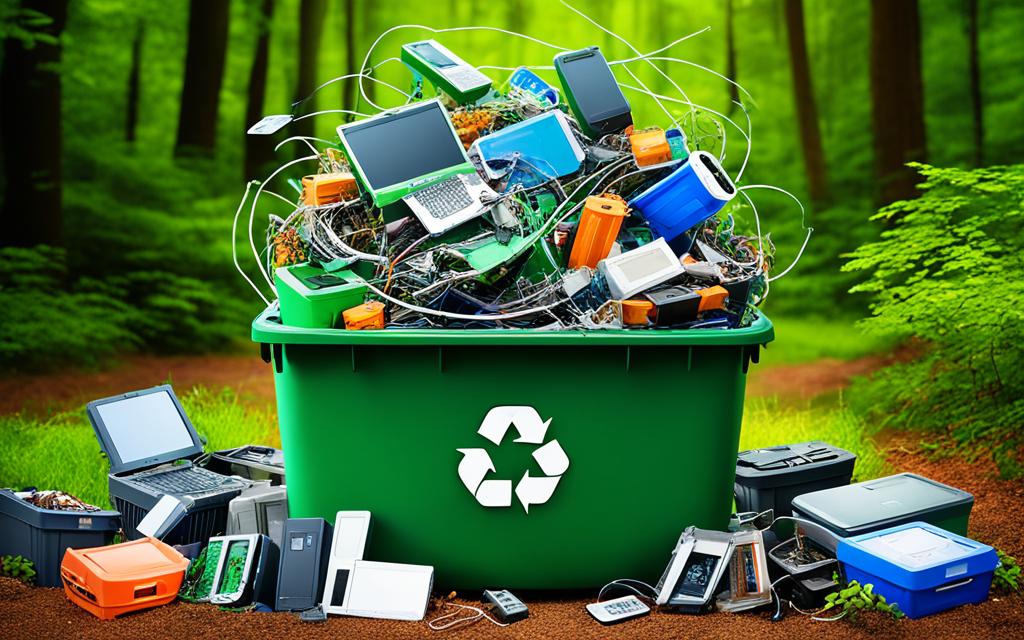The Path to Minimizing PC Waste
In our technology-driven world, the rapid pace of electronic innovations has led to a significant increase in electronic waste. It’s crucial to find ways to minimise this waste and address the environmental and health challenges it poses. One promising approach is Network Recycling, which aims to manage and reduce electronic waste through a coordinated system that connects stakeholders in the electronic lifecycle.
Minimising waste, particularly when it comes to PC disposal, is essential for creating a more sustainable future. With the United Kingdom being a hub of technological advancement, effective recycling solutions are paramount to tackling this issue.
Network Recycling offers an eco-friendly solution to PC disposal and recycling in the UK. By ensuring that electronic waste is managed efficiently and with minimal environmental impact, Network Recycling plays a vital role in reducing waste and promoting sustainable practices in the technological landscape.
In the following sections, we will delve into the e-waste problem, the implications of inadequate e-waste management, and the crucial role of Network Recycling in e-waste reduction. We will also explore the policies, advocacy campaigns, and the road ahead for achieving a more sustainable future in electronic waste management.
Join us on this journey towards minimising waste and creating a better tomorrow.
Unveiling the E-Waste Problem
Electronic waste, or e-waste, is a growing concern due to the large number of electronic devices discarded each year. This waste poses significant environmental and health risks. E-waste is projected to become one of the largest waste streams globally if the current trend continues. Understanding the scope and impact of e-waste is essential in developing effective strategies for its reduction.
The continuous advancement of technology has led to a faster obsolescence rate of electronic devices. As a result, more and more electronics are being disposed of, contributing to the accumulation of electronic waste. This waste consists of materials that can be harmful to both the environment and human health.
E-waste contains various toxic substances, such as lead, mercury, cadmium, and brominated flame retardants. Improper disposal of these electronic devices can lead to the release of hazardous chemicals into the environment, contaminating soil, water sources, and the air we breathe.
“The increasing volume of e-waste is a direct consequence of our ever-growing reliance on technology. It is crucial that we address this issue through effective e-waste reduction initiatives to mitigate the environmental and health risks associated with electronic waste disposal.”
If the current trajectory continues, e-waste is set to become one of the largest waste streams globally. The rapid advancement of technology and the growing consumer demand for newer devices exacerbate this growing problem. To tackle this issue and create a more sustainable future, it is crucial to prioritize e-waste reduction initiatives.
By implementing effective strategies for reducing e-waste, we can minimize its impact on the environment and human health. This involves promoting responsible consumption, extending product lifecycle through repair and refurbishment, encouraging recycling, and supporting eco-friendly disposal practices.
The Environmental and Health Impact of E-Waste
The improper handling and disposal of e-waste have far-reaching consequences for the environment and human health. The toxic substances present in electronic devices can contaminate soil, water sources, and nearby ecosystems. This contamination poses a threat to the biodiversity of these ecosystems and can lead to adverse effects on plant and animal life.
Furthermore, the release of harmful fumes during the incineration or informal recycling of e-waste can contribute to air pollution, exacerbating respiratory issues and other health problems in nearby communities.
The Importance of E-Waste Reduction Initiatives
Developing effective e-waste reduction initiatives is essential in addressing the growing e-waste problem. These initiatives help minimize the environmental impact of electronic waste disposal and promote sustainable resource management.
By raising awareness about the issue of e-waste and encouraging responsible disposal practices, we can reduce the amount of electronic waste that ends up in landfills or is disposed of improperly. Additionally, implementing recycling programs and supporting the development of eco-friendly technologies can help recover valuable resources from electronic waste and reduce the environmental burden.
Through collaborative efforts and innovative solutions, we can work towards a future where electronic waste is minimized, and the resources within these devices are effectively utilized and recycled.
The Implications of Inadequate E-Waste Management
Inadequate e-waste management poses significant environmental and health challenges. Improper handling of electronic waste can result in the contamination of water supplies and harm to ecosystems. Hazardous substances such as lead and mercury, commonly found in electronic devices, have the potential to cause long-term damage to both the environment and human health.
The inadequate management of e-waste also has detrimental effects on communities, particularly those living near dumpsites, especially in developing nations. These communities are at a higher risk of health issues due to exposure to the toxic chemicals present in electronic waste. The improper disposal and lack of proper recycling facilities in these areas exacerbate the problem, leading to persistent health challenges.
E-waste management is crucial for a sustainable future and the well-being of our planet and its inhabitants. Effective management practices, such as the implementation of comprehensive recycling programs like Network Recycling, are essential in addressing these environmental and health challenges.
Proper e-waste management ensures the safe disposal of hazardous materials, prevents the contamination of water sources, and mitigates the negative impact on ecosystems. It also plays a vital role in minimizing the health risks faced by communities near dumpsites.
The adoption of sustainable and responsible e-waste management practices, like Network Recycling, reduces the reliance on landfilling and promotes resource recovery and reuse. These practices contribute to the circular economy and create a more environmentally friendly approach to electronic waste disposal.
By prioritizing effective e-waste management, we can address the environmental and health challenges associated with electronic waste, paving the way for a sustainable future.
Delving into Network Recycling
Network Recycling is an innovative approach that involves a coordinated system of recycling facilities working together to tackle the growing issue of electronic waste. This approach ensures that electronic waste is managed efficiently and with minimal environmental impact, making it a key player in the global effort to reduce e-waste.
By connecting and streamlining recycling facilities, Network Recycling creates a sustainable technological landscape. It encourages the reuse and recovery of valuable resources, promoting a circular economy where electronic products are recycled and repurposed instead of ending up in landfill or being improperly disposed of.
Network Recycling offers a holistic solution to the e-waste problem by implementing practices that support the reduction, recycling, and proper disposal of electronic waste. Through this coordinated system, electronic devices are processed responsibly, minimizing the environmental and health risks associated with e-waste disposal.
Advantages of Network Recycling
- Promotes collaboration: Network Recycling connects recycling facilities, fostering collaboration and resource-sharing, which enhances the efficiency and scale of recycling efforts.
- Reduces environmental impact: By ensuring proper recycling and disposal of electronic waste, Network Recycling minimizes the release of hazardous substances into the environment, preventing pollution and ecosystem degradation.
- Encourages resource recovery: Through the reuse and recovery of materials from electronic devices, Network Recycling maximizes resource efficiency, reducing the need for raw material extraction and supporting a more sustainable supply chain.
- Creates a closed-loop system: With Network Recycling, electronic products can be recycled and repurposed, keeping valuable resources in circulation and reducing the demand for new materials.
“Network Recycling is the cornerstone of sustainable electronic waste management, offering a scalable and efficient solution for a more eco-friendly future.”– Sarah Johnson, Environmental Consultant
With its integrated approach and commitment to sustainable practices, Network Recycling is paving the way for a more sustainable technological landscape. By actively reducing e-waste and promoting responsible recycling, it plays a vital role in creating a cleaner and greener future for generations to come.
| Benefits of Network Recycling | Impacts |
|---|---|
| Reduces electronic waste | Minimizes environmental pollution |
| Promotes resource recovery | Conserves natural resources |
| Supports a circular economy | Reduces the need for raw material extraction |
| Enhances collaboration in recycling efforts | Improves recycling efficiency and scale |
The Crucial Role of Network Recycling in E-Waste Reduction
Network Recycling plays a crucial role in e-waste reduction efforts. By enhancing collaboration and resource-sharing among recycling facilities, it amplifies the scale and efficiency of recycling initiatives. This approach addresses the overwhelming statistics associated with electronic waste and helps create a more sustainable future.
Electronic waste, or e-waste, is a rapidly growing problem with serious environmental and health implications. Each year, a substantial number of electronic devices are discarded, contributing to the ever-increasing e-waste stream. If this trend continues, e-waste is projected to become one of the largest waste streams globally.
Fortunately, Network Recycling provides a comprehensive solution to this mounting problem. By connecting stakeholders in the electronic lifecycle, this coordinated system streamlines the recycling process, ensuring that electronic waste is managed efficiently and with minimal environmental impact.
One of the key advantages of Network Recycling is its ability to facilitate collaboration and resource-sharing among recycling facilities. This ensures that recycling efforts are conducted on a larger scale, maximizing the overall impact of e-waste reduction initiatives.
Moreover, by effectively managing electronic waste, Network Recycling helps address the alarming statistics associated with this issue. For instance, according to recent electronic waste statistics, over 53.6 million metric tons of electronic waste were generated globally in 2019 alone. With Network Recycling’s coordinated approach, a significant portion of this waste can be diverted from landfills and turned into valuable resources through recycling and resource recovery.
In addition to reducing the physical volume of e-waste, Network Recycling promotes sustainability by encouraging the reuse of electronic components and materials. This not only conserves valuable resources but also minimizes the need for new electronic production, further reducing the environmental impact of the technology sector.
The Benefits of Network Recycling in E-Waste Reduction
The benefits of Network Recycling in e-waste reduction efforts can be summarized as follows:
- Enhanced collaboration and resource-sharing among recycling facilities
- Amplified scale and efficiency of recycling initiatives
- Reduction of electronic waste volume and associated environmental impact
- Promotion of resource recovery and reuse
- Minimization of new electronic production and conservation of resources
By recognizing the crucial role of Network Recycling in e-waste reduction, stakeholders in the electronic industry can work together towards a more sustainable future.
Policy, Advocacy, and the Road Ahead for E-Waste Reduction
E-waste reduction policies and advocacy campaigns are essential to address the environmental and health challenges posed by electronic waste management. By implementing policies that incentivize sustainable practices and enacting stricter regulations for electronic production, governments and policymakers can make significant progress in reducing e-waste.
Recognizing the potential of innovative systems like Network Recycling, environmental advocates are championing the cause for effective electronic waste management. Network Recycling integrates the efforts of recycling facilities, promoting resource recovery and minimizing the environmental impact of e-waste. International collaboration is crucial to exchange knowledge, share best practices, and drive change in electronic waste management on a global scale.
“The growing volume of electronic waste necessitates urgent action to create a sustainable future. As policymakers, environmental advocates, and concerned citizens, it is our responsibility to promote e-waste reduction policies and advocate for effective electronic waste management systems like Network Recycling.”
The road ahead for e-waste reduction requires concerted efforts from all stakeholders. Governments must prioritize eco-friendly practices and support initiatives that promote electronic waste reduction. Policymakers need to enact laws that encourage proper disposal and recycling of electronic devices. Environmental advocates and organizations should continue to raise awareness and drive advocacy campaigns to ensure the widespread adoption of sustainable electronic waste management practices.
Advocacy Campaigns for E-Waste Reduction
Advocacy campaigns play a crucial role in raising awareness about the importance of proper electronic waste management. By educating the public and highlighting the potential dangers of improper disposal, these campaigns empower individuals to make informed choices and take action. They also encourage manufacturers to adopt more sustainable practices and create products with future recyclability in mind.
An effective advocacy campaign could include:
- Engaging with local communities through workshops and informational sessions to promote responsible e-waste disposal
- Collaborating with schools and universities to incorporate e-waste reduction education into the curriculum
- Partnering with influencers and social media platforms to reach a wider audience and encourage eco-friendly behaviors
- Lobbying for stricter regulations and incentives for sustainable electronic production and disposal
The Role of Policy in E-Waste Reduction
Policy interventions are crucial in driving change and establishing a framework for sustainable electronic waste management. Effective e-waste reduction policies should:
- Encourage manufacturers to design products with ease of recycling and resource recovery in mind
- Provide financial incentives for businesses and individuals to participate in electronic recycling programs
- Establish clear guidelines for the disposal and management of electronic waste
- Support the development of infrastructure and facilities for proper e-waste recycling
By combining advocacy campaigns and effective policy implementation, we can pave the way towards a future where electronic waste is reduced, managed sustainably, and recycled efficiently.
Conclusion
In conclusion, minimizing electronic waste is crucial for a sustainable future. With the increasing number of electronic devices being discarded each year, effective e-waste reduction strategies are essential. Network Recycling provides a comprehensive solution by connecting stakeholders in the electronic lifecycle and promoting reuse and resource recovery. By adopting Network Recycling and implementing effective e-waste reduction policies, we can make significant progress in minimizing waste and creating a more sustainable technological landscape.
E-waste reduction is not only necessary to protect our environment but also to address the health risks associated with hazardous substances found in electronics. Network Recycling offers a coordinated system that ensures electronic waste is managed efficiently and with minimal environmental impact. By encouraging collaboration and resource-sharing among recycling facilities, this approach amplifies the scale and efficiency of recycling initiatives.
To achieve a sustainable future, it is crucial for governments, policymakers, and environmental advocates to recognize the potential of Network Recycling and similar systems. Implementing e-waste reduction policies, incentivizing sustainable practices, and imposing stricter regulations for electronic production are essential steps. International collaboration and grassroots initiatives will be key drivers of change in electronic waste management. By working together, we can create a more sustainable future by reducing e-waste and ensuring the responsible disposal of electronic devices.
FAQ
What is electronic waste?
Electronic waste, or e-waste, refers to discarded electronic devices such as computers and mobile phones.
Why is e-waste a concern?
E-waste poses significant environmental and health risks due to the hazardous substances found in electronics.
What is Network Recycling?
Network Recycling is an innovative approach that connects recycling facilities to efficiently manage and reduce electronic waste.
How does Network Recycling contribute to e-waste reduction?
Network Recycling enhances collaboration and resource-sharing among recycling facilities, amplifying the scale and efficiency of recycling initiatives.
What are the implications of inadequate e-waste management?
Inadequate e-waste management can lead to environmental contamination and health issues, especially for communities living near dumpsites.
What role do policies play in e-waste reduction?
Policies that incentivize sustainable practices and stricter regulations for electronic production are essential for reducing e-waste.
How can I contribute to e-waste reduction?
You can contribute to e-waste reduction by practicing responsible disposal of electronic devices and supporting e-waste recycling initiatives like Network Recycling.













